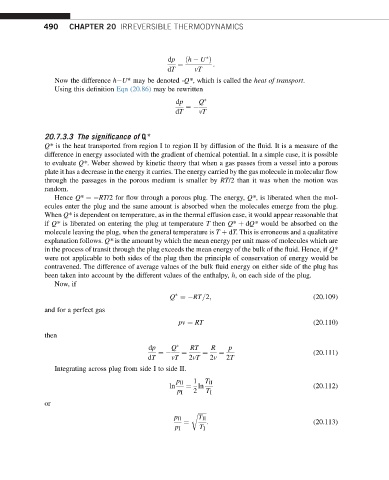Page 498 - Advanced thermodynamics for engineers
P. 498
490 CHAPTER 20 IRREVERSIBLE THERMODYNAMICS
dp ðh U Þ
¼ :
dT vT
Now the difference h U* may be denoted -Q*, which is called the heat of transport.
Using this definition Eqn (20.86) may be rewritten
dp Q
¼
dT vT
20.7.3.3 The significance of Q*
Q* is the heat transported from region I to region II by diffusion of the fluid. It is a measure of the
difference in energy associated with the gradient of chemical potential. In a simple case, it is possible
to evaluate Q*. Weber showed by kinetic theory that when a gas passes from a vessel into a porous
plate it has a decrease in the energy it carries. The energy carried by the gas molecule in molecular flow
through the passages in the porous medium is smaller by RT/2 than it was when the motion was
random.
Hence Q* ¼ RT/2 for flow through a porous plug. The energy, Q*, is liberated when the mol-
ecules enter the plug and the same amount is absorbed when the molecules emerge from the plug.
When Q* is dependent on temperature, as in the thermal effusion case, it would appear reasonable that
if Q* is liberated on entering the plug at temperature T then Q* þ dQ* would be absorbed on the
molecule leaving the plug, when the general temperature is T þ dT. This is erroneous and a qualitative
explanation follows. Q* is the amount by which the mean energy per unit mass of molecules which are
in the process of transit through the plug exceeds the mean energy of the bulk of the fluid. Hence, if Q*
were not applicable to both sides of the plug then the principle of conservation of energy would be
contravened. The difference of average values of the bulk fluid energy on either side of the plug has
been taken into account by the different values of the enthalpy, h, on each side of the plug.
Now, if
Q ¼ RT=2; (20.109)
and for a perfect gas
pv ¼ RT (20.110)
then
dp Q RT R p
¼ ¼ ¼ ¼ (20.111)
dT vT 2vT 2v 2T
Integrating across plug from side I to side II.
p II 1 T II
ln ¼ ln (20.112)
p I 2 T I
or
r ffiffiffiffiffiffi
p II T II
¼ : (20.113)
p I T I

